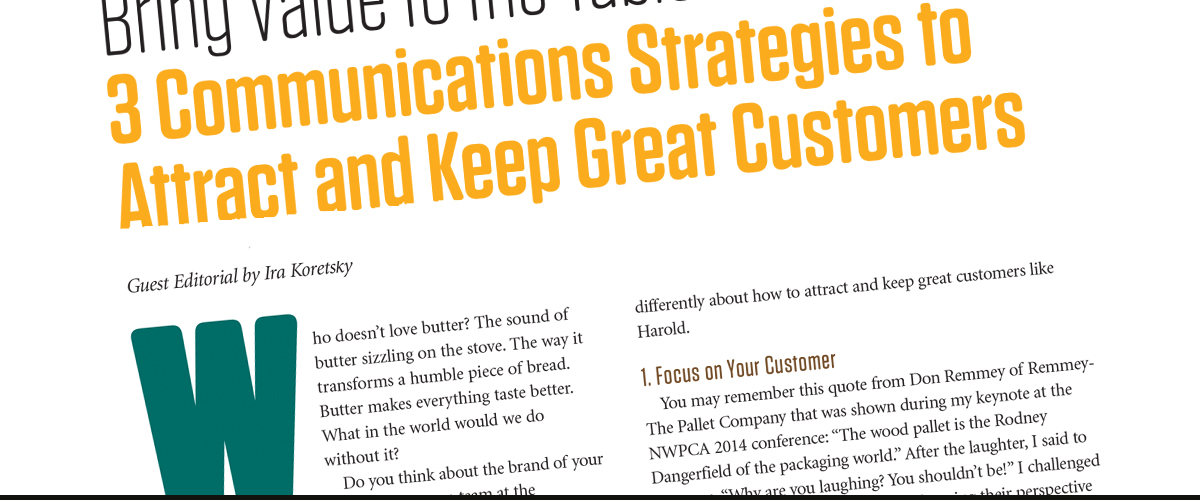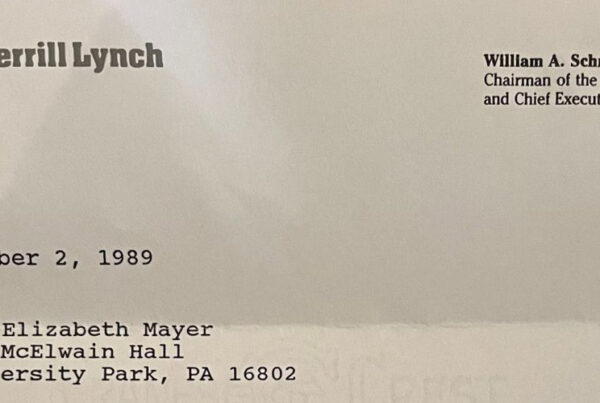
Backstory: I had the honor and pleasure of doing a keynote program for the National Wood Pallet and Container Association annual conference (NWPCA) in 2014. I have known Brent, the executive director, for years as I did a keynote for him several years prior. This keynote was all about the convergence of sales and storytelling. The article below was written after my keynote in NWPCA’s international magazine, Pallet Central, September/October 2015 issue.
3 COMMUNICATION STRATEGIES TO ATTRACT AND KEEP GREAT CUSTOMERS
© 2015. The Chief Storyteller®, LLC.
Ira J. Koretsky
September 2015
Who doesn’t love butter? The sound of butter sizzling on the stove…The way it transforms a humble piece of bread. Butter makes everything taste better. What would the world be without it?
Do you think about the brand of your butter? Last year, a team at the University of Chicago found that you probably do. Guess what else they found: most professional chefs do not. Surprised?
The study concluded the public buys national brands of butter because of personal experiences and information from third-party sources such as advertising. I assert the same is true in your world. Even if you are selling a 48×40 recycle GMA pallet, what you say and what you do with your customer, shape the selling experience.
During my interviews, several of you told me “Sell on value, not on price.” Others told me, price is a key decision factor, and for some customers, “price is all that matters.” Which is it then: Value or price? How is it some NWPCA members are growing and others are feeling squeezed?
Todd Askew from Biewer Lumber shared an insightful story about Harold, an industrial client. Harold received unsolicited calls from competitor mills offering lower prices. Harold always told them, “I can’t afford the savings.” What a powerful statement. Harold could not afford to jeopardize his client relationships with in all likelihood, lower quality lumber.
Here are three communications strategies to inspire you to think differently about how to attract and keep great customers, like Harold.
1. FOCUS ON YOUR CUSTOMER
“The wood pallet is the Rodney Dangerfield of the packaging world.” You may remember this Don Remmey quote I showed during my keynote at the NWPCA 2014 conference. After the laughter, I said to everyone, “Why are you laughing? You shouldn’t be!” I challenged everyone to change the status quo by changing their perspective and changing the perspective of their prospects and clients.
To grow, you have to be better than your competition. If you let the status quo carry the day, the next day will be the same, and so forth. If your customers and prospects simply want a price quote time after time, it’s time to change your prospecting strategy.
It’s also time to change your words. When I look at your marketing materials and listen to your conversations, you often use “We” words — We, Us, Our, and Company Name. What you say, write, and post online is not for you. It is for your prospects and customers. Make them the center of EVERYTHING.
An easy way to start this mind shift is to look at the We/You ratio in your marketing materials. Count the We’s (i.e., We, Us, Our, Company Name). Then count the You’s (i.e., You, Your, Customer, Client). Audio record a few sales visits and telephone calls and count again. If your ratio is far from 30% We to 70% You, it’s time to revise your messaging.
By shifting the focus to your prospects and customers, your messaging WILL change. You’ll focus on your prospect’s goals and how you can help them, rather than selling on price.
It has been said “People prefer to do business with those they know, like, and trust.” What can you do to shift the sales process from purely transactional to one more centered on the relationship?
2. SELL VALUE, SELL VALUE, SELL VALUE
Mia Allen and Amy Angellotti of Rose Pallet shared, “We’re not interested in living and dying by price. We’re interested in a full ‘pallet management’ relationship with our customers. We focus on relationship selling and great customer service. We’re not about the transaction. Ever.”
There is absolutely no better way to sell your value than to demonstrate the problem, solution, and the results you have achieved for your clients time and time again. Develop a success story library with specific messages.
Examples:
- Above & Beyond Customer Service
- We Make the Impossible, Possible
- We’re a Phone Call Away
- Ask Us Anything, We’ll Find the Answer
Develop 1, 2, 5, and 10-minute versions of your stories (See link below). Share these with your sales and customer service teams and continue to add and update.
Jimmy Wilson of Bay Wood Products, sets himself apart by being an information resource for his customers. He shares wide-ranging information about legislation, lumber, and international events. He emails a quarterly “President’s Letter,” which shares more personal information such as his charitable activities, showcasing Bay Wood Products as a company that cares.
Think of yourself a consultant. Create a list of all of the activities you perform on behalf of your customers, before the deal, during, and after. What do your customers get out of the extra mile you go? Highlight these differences and benefits to them. Demonstrate your value as a trusted, go-to-partner who understands your customers’ needs.
3. MAKE CUSTOMER SERVICE PRIORITY ONE
Without exception, every single person I have ever interacted within a commoditizing environment tells me customer service is the best way to build customer loyalty.
Mia and Amy from Rose Pallet were emphatic, “Service, Service, Service. We are on our phones all of the time. We get back to customers within minutes. Some of our customers told us our competitors were NOT EVEN returning calls. Some told us that when they requested a facility visit, they were told, ‘Our reps don’t travel.’” Not returning calls? Not traveling? Examples like these take price out of the discussion. Period.
And then, there is going above and beyond. Mia and Amy send hand-written thank you notes to new prospects. Todd sends goodie boxes to brand new customers. Jimmy sends out his President’s Letter. These are Moments of Impact. Little things that show you genuinely care. Happy Birthday calls, How was Your Trip? notes, remembering details about family (Do an Internet search on “The Mackay 66™ for Customers” for a great tool), and sending thoughtful gifts such as golf balls and fishing lures.
The attention you show your customers profoundly shapes your reputation. When you are introduced to a prospect, have they already heard of you and your company? What did they think or know about you before even meeting you? Outstanding customer service differentiates you from your competition.
TAKE THE LONG VIEW
Shifting from transaction and price to relationships and value takes time. Attracting and keeping great customers takes time. And building a rock-solid reputation, to the point where your customers tell competitors, “I can’t afford the savings,” takes time.
The late poet Maya Angelou said something so profound, that reading it for the 1,000th time still means the same as when I read it the first time: “People will forget what you said, people will forget what you did, people will never forget how you made them feel.”
ADDITIONAL READING ON MARKETING, STORYTELLING, AND PUBLIC SPEAKING
- 5 Steps to Mastering Fundamentals of Presenting with the “1-2-5-10” Exercise
- Write to the 10th Grade Level to [Dramatically] Improve Audience Engagement
- Great Leaders are Great Storytellers – 5 Tips to Improve Your Leadership Effectiveness
- Building a Relationship? Give Options for BOTH Coffee and Lunch
- No is Yes in Disguise – Why No is Better than Yes
Photography Source: © Copyright 2015, The Chief Storyteller®, LLC. All Rights Reserved.



